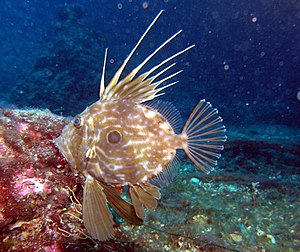Petersfish
| Petersfish | ||||||||||||
|---|---|---|---|---|---|---|---|---|---|---|---|---|

Petersfisch ( Zeus faber ) |
||||||||||||
| Systematics | ||||||||||||
|
||||||||||||
| Scientific name | ||||||||||||
| Zeidae | ||||||||||||
| Latreille , 1825 |
The Peter fish (Zeidae) were named after Zeus , the supreme god of Greek mythology. The animals live in the Atlantic , Indian and Pacific . All species are commercially caught with deep-sea trawls.
shape
All St. Peter's fish share the same high, compressed body, large head with the characteristic concave profile and large mouth. The mouth is clearly above in the genus Zenopsis . The jaws are massive.
The animals have a high back. The large first, hard-edged dorsal fin has 7–10 rays, which in adult fish are often elongated like a thread. The second, soft-rayed dorsal fin has 22–37 rays. The caudal peduncle is thin and the caudal fin is small. The pectoral fins are small, short and round in shape. Ventral fins elongated. It is unusual that the anal fin also consists of two parts. The first part has 1-4 hard rays and the second soft-rayed part 20-39 fin rays. Bone plates that form an armored keel stretch along the abdomen and at the base of the dorsal and anal fin.
The animals, which are usually bright silver, have no or very small scales. They sometimes have a dark spot on their flank. Zeus capensis and the herring king ( Zeus faber ), which also occurs in European waters, are 90 centimeters long. The other four species remain smaller.
Way of life
The fish that live in the open water are usually found in medium water depths or over muddy bottoms at depths of 50 to 500 meters above the continental shelf . They are slow swimmers who use their dorsal and anal fins for propulsion. The paired fins are used for balance or when changing direction.
nutrition
Young Peterfish feed on zooplankton , while adults hunt schooling fish such as herrings , sardines and young mackerel , or they also eat cephalopods such as squids . You yourself become a victim of sharks .
Multiplication
Petersfishes are free spawners. The eggs are heavier than the water, sink to the bottom and adhere to the substrate. The fish grow quickly and become sexually mature at 3 to 4 years of age.
They have been known in fossil form since the Oligocene , the youngest stage of the Paleogene , about 20 to 30 million years ago.
Systematics
There are two genera with seven species:
- Genus Zenopsis Gill , 1862 .
- Zenopsis conchifer (Lowe, 1852) .
- Zenopsis filamentosa Kai & Tashiro, 2019 .
- Zenopsis nebulosa ( Temminck & Schlegel , 1845) .
- Zenopsis oblonga Parin, 1989 .
- Zenopsis stabilispinosa Nakabo et al., 2006 .
- Genus Zeus Linnaeus , 1758 .
- Zeus capensis Valenciennes , 1835 .
- Petersfisch ( Zeus faber ) Linnaeus, 1758 .
literature
- Joseph S. Nelson: Fishes of the World , John Wiley & Sons, 2006, ISBN 0-471-25031-7
- Kurt Fiedler: Textbook of Special Zoology, Volume II, Part 2: Fish . Gustav Fischer Verlag, Jena 1991, ISBN 3-334-00339-6
Individual evidence
- ↑ Kai, Y. & Tashiro, F. (2019): Zenopsis filamentosa (Zeidae), a new mirror dory from the western Pacific Ocean, with redescription of Zenopsis nebulosa. Ichthyological Research, [1-13]. January 2019.
Web links
- Petersfische on Fishbase.org (English)
